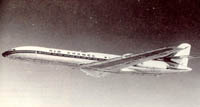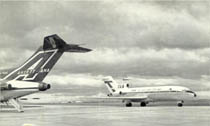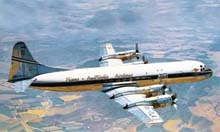Battle Lines
TAA was seen to have an unfair advantage and the Liberal government's benevolent attitude to ANA was emphasized in 1955 when it legislated to maintain control by directing TAA to exchange 3 turbo-prop Viscount aircraft with ANA, for 2 slower and older, piston-engine Douglas DC6Bs, and then direct TAA to buy a third DC6B to maintain seat parity, and equipment similarities.

Irrespective of TAA's objections to this decision, TAA was bound by its obligation to conform as the government held the 'purse strings', and was also the dictator of the industry.
This policy would be in vogue for over twenty years, constantly being amended, and it was the inhibitor for the introduction of pure jet aircraft to this country.
TAA had in 1956 assessed, and then placed orders for the French Caravelle twin jet.

TAA had also assessed the British Trident twin jet, and aircraft from the USA, and the Caravelle at the time was considered the most acceptable for Australian conditions.
Due to the legislation, TAA had to cancel this contract and abide by the agreement introducing slower and older technology in the form of the Lockheed Electra Mk2, an 84 seat turboprop aircraft until its competitor was financially able to support the introduction of pure jet aircraft, in 1964.
With the death of Ivan Holyman, the General Manager of ANA, in 1957, the government reassessed air travel, subsidies, and general performance of each airline.
ANA continued to receive subsidies, while TAA was returning a profit, but the managers of ANA were unwilling to inject additional funds to maintain the established controlled competition.
The government therefore suggested to ANSETT Airways of Hamilton in Victoria, that it was the most likely alternative to maintain a competitive environment and that it might make a takeover bid for ANA.
Reginald Miles ANSETT was General Manager and owner, and Ansett Airways held some 15% of the domestic network as a minor operator
His initial bid of £3,000,000 (pounds) was rejected and so with assistance from the government and the Shell Oil Company (a further £300,000) he made a second and final bid, which was begrudgingly accepted by the shipping companies and ANSETT-ANA became the second airline.

Ansett, now with a large debt, could not afford to introduce pure jet aircraft in 1959, and convinced the government that if he was to compete as per the two airlines agreement, ANSETT-ANA could introduce the cheaper, but larger aircraft, the Lockheed Electra Mk2. The government agreed and TAA was forced to cancel the Caravelle and order the Lockheed aircraft.
